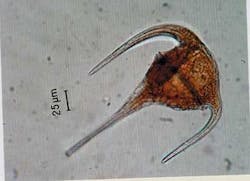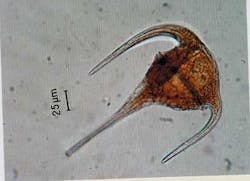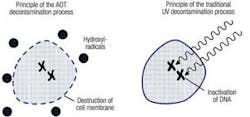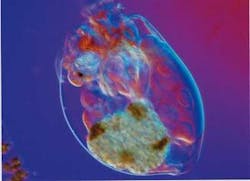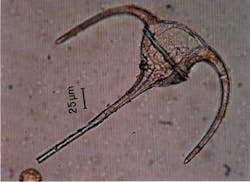Unwanted transplants
The Alfa Laval Ballast Water Treatment System protects against one of the four greatest threats to the world's oceans - species introduction.
One of the greatest dangers to the health of oceans comes from the accidental transplanting of species from one part of the globe to another via ships' ballast water, according to the International Marine Organisation (IMO). Global warming, agricultural run-off, detergents and chemicals discharged from urban coastal development also contribute to major water quality problems, But, the IMO considers "species introduction" as one of the four greatest threats to the world's oceans given its ecologically devastating effects.
Ships use ballast water to trim the vessel and aid steering when they are running empty or carrying minimal cargo. A coastal vessel or one plying the inner waters of the Great Lakes complex will, typically, have a ballast water load of around 14 million gallons while its ocean-going equivalent would carry more than double that volume.
However, when ships take on ballast, it's not just water that makes the journey with them; unwelcome guests such as microscopic organisms, eggs, cysts and the planktonic larvae of larger organisms float about in the ballast tanks. Scientists estimate that at least 7,000 different species can be found in the ballast tanks of ships criss-crossing the globe. Since, according to one report, approximately 180,000 ships visit European ports annually, discharging 105 million tonnes of ballast water from origins ranging from the Baltic to Australia, the chances of accidentally transplanting alien species are very high.
For example, the Zebra Mussel was imported in the ballast water of transoceanic ships around 1986, but first discovered in 1988 in the Great Lakes region. Since then they have spread to other lakes and rivers in the US and Canada. They are prodigious consumers of phytoplankton (and small zooplankton) in the 15- to 40- micron range. Since these are the main food source for larval and juvenile fishes and other animals, Zebra Mussels eventually starve the indigenous population of the lakes and rivers they invade.
Mid-ocean exchange of ballast water is currently the main defence against transplantation. Ships entering the US must exchange ballast water obtained in harbour for ocean water from areas at least 200 miles from any shore and at least 2,000-metres-deep, before they can discharge it in US coastal waters. The rationale is that any coastal or freshwater species taken on board at the start of a ship's voyage will be largely eliminated in mid-ocean either by emptying and refilling ballast tanks or by flow-through dilution.
However, although this practice eliminates many potential problems, it is difficult to police, particularly in countries without the money and personnel needed to do so effectively. Consequently, not all organisms are eliminated and those that do survive often end up in completely new environments when the ship discharges its ballast water at its final destination. That is when the problems begin.
As the Zebra Mussel example clearly demonstrates, transplanted species can attack or usurp indigenous ones, sometimes leading to the total collapse of an ecosystem. This can create health problems and, in extreme cases, even deaths. Worse yet, the pollution problems posed differ from virtually all others in that the effects are irreversible.
This is why the International Marine Organisation (IMO) has identified species introduction as one of the four greatest threats to the world's oceans. The cost of trying to halt or limit the flow of invasive species costs billions of dollars each year in control measures and loss of industrial income. The problem is unlikely to go away any time soon.
Some experts estimate that alien species are introduced to a new region worldwide every nine weeks. Given the anticipated growth in global shipping and the opening up of new seaways, the problem could become three times worse than it currently is unless organisations such as the IMO and companies serving the global marine industry can devise a viable solution.
For its part, the IMO has already taken positive action. Between 2000 and 2004, it spent more than US$ 10 million on a trial control programme at six different locations around the world. Now, it has launched the next stage of the same initiative called Globallast (Global Ballast Water Management Programme) - in conjunction with the Global Environmental Facility and the United Nations Development Programme - that will assist developing countries implement control and testing procedures.
Along with other major marine suppliers, Alfa Laval has been working to develop systems capable of preventing the problem at source. It has developed a Ballast Water Treatment System, based around the patented Benrad Advanced Oxidation Technology (AOT). A full-scale 500 m3/h pilot plant has been used for commercial trials on board a transoceanic vehicle transport ship since 2003 and it is anticipated that commercial units will be generally available by 2006.
The advantage of the Alfa Laval Ballast Water Treatment system is that it involves no chemicals and requires little energy to run. Consequently, its environmental impact is negligible, yet it effectively deals with the problem of transplantation of species by treating ballast water as it is taken on board and, again, before it is discharged. The system consists of a filter to remove larger particles, a modular Benrad AOT unit, a cleaning system for the AOT and a fully automated control system for the complete installation.
The core of the Alfa Laval Ballast Water Treatment System, the AOT, uses low doses of a special ultraviolet (UV) light in combination with catalysts to create Hydroxyl (OH) radicals to break down micro-organisms and bacteria. Unlike conventional UV treatment, which destroys the DNA of the micro-organism's cell, Hydroxyl radicals attack and destroy the cell membrane and prevent it from reproducing.
This methodology effective and requires substantially less energy than conventional UV treatments, with operating costs below 0.01
Alfa Laval ran onshore tests, simulating AOT treatment at ballasting, on natural seawater in 2003. These demonstrated that the system deals with micro-organisms such as Zooplankton and phytoplankton up to 50
Since it is modular, the AOT system can be sized to meet the individual needs of each vessel. Currently, the range covers flows from 250 to 500 m3/h of ballast water. Water is treated both as it is taken on board and again at discharge. The initial treatment limits the number of viable organisms entering the vessel and prevents sediment build-up in the tanks, which would be a potential area for development and breeding. The water is then also treated on discharge to capture any organisms that might have escaped the initial treatment.
The Alfa Laval system is fully automatic and can be adapted to different types of vessel. It is also designed to match the working life of a modern sea-going vessel of between 25 and 30 years. The filter is installed on the discharge side of the ballast water pumps and is designed to self-flush automatically. At ballasting, the back-flush water is vented to the ocean. When the ballast water is being discharged, the filter is by-passed to prevent any risk of contamination in the discharge area. Regular cleaning using a biodegradable cleaning solution enhances the system's eco-friendliness.
Its environmental qualities were recognised by a very discerning audience at the Seventeenth Annual Seatrade Awards, held in London on April 18 this year, when the Alfa Laval Ballast Water Treatment System won the prestigious award for "Protection of the Marine and Atmospheric Environment," sponsored by the Maritime Coastguard Agency.
Author's Note
Peter Rose is the marketing manager for Alfa Laval Limited, located in Camberley, Surrey, UK. For more information, visit the website www.alfalaval.co.uk.
Hydroxyl OH
- Hydroxyl (OH) consists of one oxygen and one hydrogen atom which does not normally exist in a stable form
- The hydroxyl radical (OH) is so small that 10 billion billions would fit in a raindrop.
- Hydroxyl has sometimes been labelled Mother Nature's Broom because of its ability to clear the air of pollutants and break down other chemicals. Despite its diminutive size, OH is probably the single most important cleansing agent in the earth's atmosphere.
- Hydroxyl OH has a life of less than a second.
